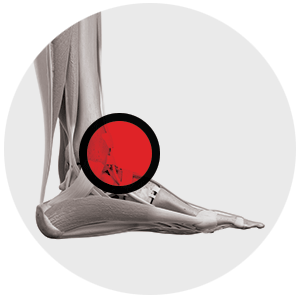Ankle Arthritis

Ankle Arthritis
Ankle arthritis is loss of the ankle joint cartilage lining. It usually occurs over a period of years. The most common cause is previous trauma but in some patients it may occur as part of a systemic disease such as rheumatoid arthritis, haemophilia or gout. Irrespective of cause, the effect is similar, the joint space of the ankle narrows between the tibia and the talus, bony spurs develop, the ankle becomes painful and stiff, and may or grind or lock up. Even though it is less prevalent than arthritis affecting the hip and knee, it can be just as debilitating and painful.
Non-Operative Management
Early or mild ankle arthritis is treated with simple measures such as activity lifestyle modification, physically losing some weight, using a walking aid, avoiding impact activities. When it becomes more severe oral analgesics are required. Some people use medications such as glucosamine and fish oil to help them. Medications may be combined with physiotherapy, orthotics and shoe modifications. A patient may even require ankle bracing or a custom fitted splint. Injection therapy can be useful with the use of steroid, platelet rich plasma or a lubricant hyaluronate. The degree and extent of relief can vary from patient to patient.
Operative Management
When the non-operative measures fail, there are 3 main surgical options:
- Arthroscopic debridement;
- Joint arthrodesis;
- Joint replacement
The best option for each patient needs to be individualised, it depends up on the severity of the arthritis, the age of the patient, functional demands and the presence of arthritis in other joints. Dr Rao will explain to you what is the preferred option for your ankle arthritis.
Arthroscopic debridement involves a day case or overnight admission with a relatively rapid recovery. A camera is placed inside the ankle, loose cartilage is removed, bony spurs and loose bodies can also be removed. This procedure does not “cure the arthritis”. Around 70%-80% of people will experience an improvement in symptoms but in 2% of patients, the procedure may actually accelerate the deterioration. This may mean that further surgery is required.
Ankle arthrodesis is the gold standard treatment. This involves removing bone from the tibia and talus and holding them together with screws with a plate. Dr Rao uses many options for fixation but prefers the Arthrex lateral ankle fusion plate. In terms of movement of the ankle, you will lose half the movement you already have. This is due to the fact that adjacent joints can “take up the load” from the fused ankle joint. This procedure can be performed a number of ways, either arthroscopically or via an open procedure. Dr Rao will explain to you which is the preferred option in your case. The main role of fusion is to provide long term pain relief resulting in a limp free gait and returning to activities that you wish. Potential complications will be discussed with you. Dr Rao gives you a 90%-95% chance you will be happy with the procedure 6 months down the track. The main complications that may require further surgery include failure of the bones to fuse and 10% may require surgery elsewhere in the foot for arthritis.
Total ankle replacement is a relatively new procedure compared to hip and knee replacements. One metal component is fixed to the tibia and the other to the talus. A third component is a dense plastic known as polyethylene which glides between the 2 metallic components. This procedure does give good pain relief and also helps to preserve some of the pre-operative motion. It does reduce the stress on the knee and other joints of the foot. It is best suited to more elderly patients, over 65, with lower physical demands and a well aligned ankle. The main disadvantage is that the parts can wear out, this occurs in around 2%-3% of people. If that does occur, it is possible to revise the ankle replacement, it is more common to proceed to an ankle fusion. Again, potential complications will be discussed with you by Dr Rao. Around 90% of patients are satisfied, 5% will have a wound problem. 5% of people will have the ankle replacement fail, 10% of people may require some sort of adjustment to the ankle replacement in the first 5 years. At this state 80% of ankle replacements are functioning well after 10 years.
Recovery Times
In terms of hospital stay:
- 3-4 nights in hospital;
- Rest and elevation for 2 weeks;
- Backslab for 2 weeks;
- Boot for 8-10 weeks;
- Crutches and frame for 8-10 weeks;
- Time off work:
- for seated jobs, 4-6 weeks
- for standing jobs around 3 months. The aim is to have you walking well by 3 months
- Swelling should settle over 6 months but the final result is really determined at the 12 month post-operative appointment.
Meet Dr Rao
Dr Rao is a Newcastle Orthopaedic surgeon who specialises in all aspects of foot and ankle surgery. He graduated from medicine at the University of Sydney and trained as an orthopaedic surgeon in Newcastle and also in Queensland.
He also undertook further training by way of fellowship with world famous Dr Terry Saxby in Brisbane in 2008. He has also conducted further training by attending numerous courses overseas, in Thailand, the USA and right across Australia.

